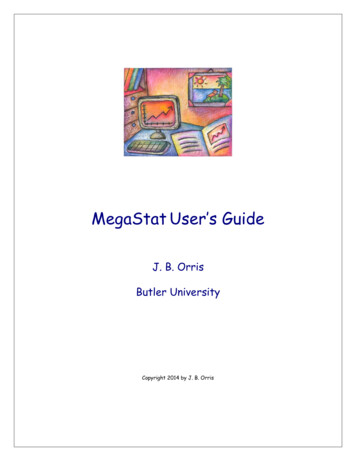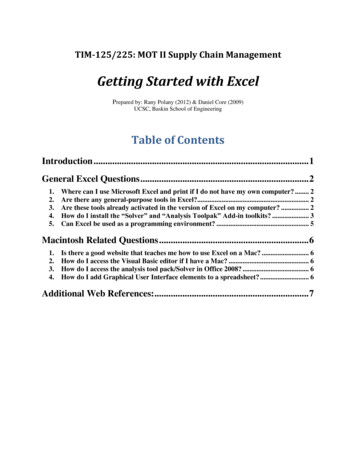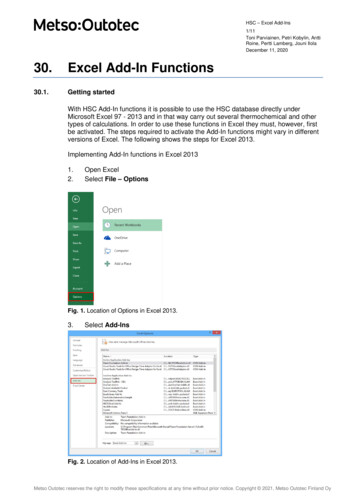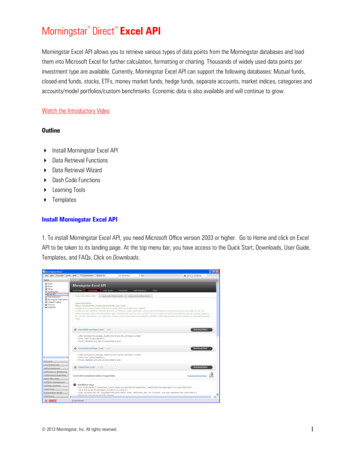
Transcription
Using the MorningstarExcel Add-InOnboarding GuideDirect
Copyright 2020 Morningstar, Inc. All rights reserved.The information contained herein: (1) is proprietary to Morningstar and/or its content providers; (2) may not be copiedor distributed; (3) is not warranted to be accurate, complete or timely; and (4) does not constitute advice of any kind.Neither Morningstar nor its content providers are responsible for any damages or losses arising from any use of thisinformation. Any statements that are nonfactual in nature constitute opinions only, are subject to change withoutnotice, and may not be consistent across Morningstar. Past performance is no guarantee of future results.Morningstar Direct January 2020 2020 Morningstar. All Rights Reserved.
ContentsOverview . . . . . . . . . . . . . . . . . . . . . . . . . . . . . . . . . . . . . . . . . . . . . . . . . . . . . . . . . . . . . . . . 4What basic formulas does the Morningstar Excel Add-In offer?. . . . . . . . . . . . . . . . . . . . . 4Installing and Configuring the Morningstar Excel Add-In . . . . . . . . . . . . . . . . . . . . . . . . . . . . . 5Overview . . . . . . . . . . . . . . . . . . . . . . . . . . . . . . . . . . . . . . . . . . . . . . . . . . . . . . . . . . . . . . . . 5Exercise 1: Install the Morningstar Excel Add-In . . . . . . . . . . . . . . . . . . . . . . . . . . . . . . . . 5Exercise 2: Log in to the Morningstar Excel Add-In . . . . . . . . . . . . . . . . . . . . . . . . . . . . . . 6Exercise 3: Change the settings for the Morningstar Excel Add-In . . . . . . . . . . . . . . . . . . 8Exercise 4: Update the settings for Microsoft Excel . . . . . . . . . . . . . . . . . . . . . . . . . . . 10Retrieving the Members of a Saved List or Search . . . . . . . . . . . . . . . . . . . . . . . . . . . . . . . . . . 11Overview . . . . . . . . . . . . . . . . . . . . . . . . . . . . . . . . . . . . . . . . . . . . . . . . . . . . . . . . . . . . . . .Exercise 5: Download the sample spreadsheet . . . . . . . . . . . . . . . . . . . . . . . . . . . . . . . .Exercise 6: Retrieve an existing list of investments . . . . . . . . . . . . . . . . . . . . . . . . . . . . .What are the component parts of the MSMEMBER formula? . . . . . . . . . . . . . . . . . . . . .11111113Retrieving Supplementary Data for Investments . . . . . . . . . . . . . . . . . . . . . . . . . . . . . . . . . . . 15Overview . . . . . . . . . . . . . . . . . . . . . . . . . . . . . . . . . . . . . . . . . . . . . . . . . . . . . . . . . . . . . . .Exercise 7: Retrieve supplementary data points . . . . . . . . . . . . . . . . . . . . . . . . . . . . . . .Exercise 8: Apply a formula to additional investments . . . . . . . . . . . . . . . . . . . . . . . . . .Exercise 9: Retrieve multiple data points at once . . . . . . . . . . . . . . . . . . . . . . . . . . . . . .15151719Retrieving a Historical Series of Data Points for Investments . . . . . . . . . . . . . . . . . . . . . . . . . 20Overview . . . . . . . . . . . . . . . . . . . . . . . . . . . . . . . . . . . . . . . . . . . . . . . . . . . . . . . . . . . . . . .Exercise 10: Retrieve time series data points . . . . . . . . . . . . . . . . . . . . . . . . . . . . . . . . . . .Exercise 11: Manually modify a formula. . . . . . . . . . . . . . . . . . . . . . . . . . . . . . . . . . . . . . .Exercise 12: Retrieve standard deviation values . . . . . . . . . . . . . . . . . . . . . . . . . . . . . . . .Exercise 13: Add the tracking error. . . . . . . . . . . . . . . . . . . . . . . . . . . . . . . . . . . . . . . . . . .Exercise 14: Add the Sharpe Ratio . . . . . . . . . . . . . . . . . . . . . . . . . . . . . . . . . . . . . . . . . . .Exercise 15: Link formulas to a reference cell . . . . . . . . . . . . . . . . . . . . . . . . . . . . . . . . . .Exercise 16: Retrieve Historical Series data . . . . . . . . . . . . . . . . . . . . . . . . . . . . . . . . . . . .2020232426283031Retrieving a Portfolio’s Holdings. . . . . . . . . . . . . . . . . . . . . . . . . . . . . . . . . . . . . . . . . . . . . . . . 36Overview . . . . . . . . . . . . . . . . . . . . . . . . . . . . . . . . . . . . . . . . . . . . . . . . . . . . . . . . . . . . . . .Exercise 17: Retrieve portfolio holdings for a fund using the MSHOLDING formula . . . .Exercise 18: Retrieve only the top 10 holdings for a fund . . . . . . . . . . . . . . . . . . . . . . . . .Exercise 19: Retrieve historical positions for a fund. . . . . . . . . . . . . . . . . . . . . . . . . . . . . .36363839Retrieving Ownership Information for an Investment. . . . . . . . . . . . . . . . . . . . . . . . . . . . . . . . 40Overview . . . . . . . . . . . . . . . . . . . . . . . . . . . . . . . . . . . . . . . . . . . . . . . . . . . . . . . . . . . . . . . 40Exercise 20: Retrieve ownership data for a stock. . . . . . . . . . . . . . . . . . . . . . . . . . . . . . . . 40A short note on using Dash Codes . . . . . . . . . . . . . . . . . . . . . . . . . . . . . . . . . . . . . . . . . . . 42Morningstar Direct January 2020 2020 Morningstar. All Rights Reserved.3
Using the Morningstar Excel Add-InThe Morningstar Excel Add-In allows users to retrieve data points from the Morningstardatabases within Microsoft Excel for further calculation, formatting, or charting.Think of it as an alternative to exporting data from Morningstar DirectSM.OverviewThis guide offers information about the Add-In and a series of exercises showing usershow to leverage some of its key features. Note that this tool must be installed separatelyfrom the Morningstar Direct application.The Morningstar Excel Add-In allows users to retrieve data from Morningstar Directusing the commands described in the following table:Use thiscommand To retrieve this type of data from thedesktop version of Morningstar Direct MSMEMBERInvestments included as part of a saved list or searchMSDPThe current value of a data pointMSTSHistorical values for a data point, over a time period you defineMSHOLDINGThe holdings of a investment’s portfolioMSDATEDynamic time periodsWhat basic formulasdoes the MorningstarExcel Add-In offer?This guide includes the following lessons:g Installing and Configuring the Morningstar Excel Add-In (page 5)g Retrieving the Members of a Saved List or Search (page 11)g Retrieving Supplementary Data for Investments (page 15)g Retrieving a Historical Series of Data Points for Investments (page 20)g Retrieving a Portfolio’s Holdings (page 36)g Retrieving Ownership Information for an Investment (page 40)Morningstar Direct January 2020 2020 Morningstar. All Rights Reserved.4
Installing and Configuring the Morningstar Excel Add-InOverviewInstalling and Configuring the Morningstar Excel Add-InBefore using the Morningstar Excel Add-In, it must be installed. Additionally, it will beworthwhile to spend a few minutes configuring both the settings within the Add-In, aswell as Microsoft Excel itself to optimize the use of this tool.OverviewIf you do not have installation rights on your computer, work with your firm’s ITdepartment to have the Morningstar Excel Add-In installed for you. If you do haveinstallation rights on your computer, you can install it by doing the following:Exercise 1: Install theMorningstar Excel Add-In1. Visit http://addin.morningstarcommodity.com/.2. To the right of the Latest Version, click Download. Note: Users will need to regularly visit this page to download updated versions of theapplication as new features and capabilities are introduced for the Add-In.Use this button to accessthe download files forthe latest version of the Add-In.3. Under the Executable package (.exe), click Download.Use this button to downloadthe installation wizard that willwalk you through adding theAdd-In to Microsoft Excel .4. Open the .exe file and follow the prompts to install it.Morningstar Direct January 2020 2020 Morningstar. All Rights Reserved.5
Installing and Configuring the Morningstar Excel Add-InExercise 2: Log in to the Morningstar Excel Add-In5. To see that the Add-In appears as expected, open Microsoft Excel .Once installed, the MorningstarAdd-In capabilities can beaccessed from this tab.When accessing the Morningstar Excel Add-In for the first time, only the followingicons are seen under the Morningstar tab:Exercise 2: Log in to theMorningstar Excel Add-InTo use the Morningstar Excel Add-In, users must enter their Morningstar Direct logincredentials. To login, do the following:1. Under the Morningstar tab, click Profile Direct. The Morningstar Add-In login dialogbox opens.Select this option to accessthe features of the Add-In.Morningstar Direct January 2020 2020 Morningstar. All Rights Reserved.6
Installing and Configuring the Morningstar Excel Add-InExercise 2: Log in to the Morningstar Excel Add-In2. Enter the e-mail address and password used to access Morningstar Direct, thenclick Log In.The login details entered here aresaved, and will not be required again.The complete Morningstar Excel Add-In toolbar is now available.Note the additionalicons now available.Morningstar Direct January 2020 2020 Morningstar. All Rights Reserved.7
Installing and Configuring the Morningstar Excel Add-InExercise 3: Change the settings for the Morningstar Excel Add-InThe Morningstar Excel Add-In has its own settings to control the following items:g What should be displayed when no data or value is available for an item?g When the Morningstar Rating and Morningstar Style Box are displayed, shouldthey appear as symbols, or numbers?g How do you want to save data in your computer’s memory when using theMorningstar Excel Add-In for the sake of optimizing performance?g When a change is made to a formula in a worksheet, do you want the tool toautomatically recalculate values, or do you want to manually control this update?Exercise 3: Change thesettings for theMorningstar Excel Add-InTo configure these settings, do the following:1. From the Morningstar tab, click Profile Preferences. The Morningstar Add-In dialogbox opens.Select this option to configurecertain aspects of the Add-In.Morningstar Direct January 2020 2020 Morningstar. All Rights Reserved.8
Installing and Configuring the Morningstar Excel Add-InExercise 3: Change the settings for the Morningstar Excel Add-In2. Under No Value Displayed, choose one of the following options:g N/A to show N/A when data is not availableg Blank to show a blank cell when data is not available, org – to fill a cell with a dash when data is not available.3. Under the Morningstar Ratings and Style Box section, choose whether to display thedata as number or text or as a symbol.4. Under the Data Retrieval Settings section, leave these settings unchanged. Note: Leaving the box for Enable Local Cache checked allows for faster performance and dataretrieval by saving data in your computer’s local memory.5. To automatically recalculate all data when a formula is changed or added, leave theAuto calculate box selected. To manually control when data in the spreadsheet isupdated, de-select this checkbox. Think about the impact of this option if you plan to useother fields/cells in Microsoft Excel with your own formulas, which would also beimpacted by this setting.Set what options youwould prefer to use here.6. Click OK.Morningstar Direct January 2020 2020 Morningstar. All Rights Reserved.9
Installing and Configuring the Morningstar Excel Add-InExercise 4: Update the settings for Microsoft Excel The Morningstar Excel Add-In allows each user to retrieve 500,000 data points per day;this daily limit is reset at the end of the day. Setting the formulas you create to Manualcalculation saves your data while creating your work. You can decide to switch back toAutomatic calculation at a later stage from the Formula tab or by going back to File Options Formulas.Exercise 4: Updatethe settings forMicrosoft Excel To avoid calculating the same data points several times while working on a template,do the following:1. In Microsoft Excel select, File Options. The Excel Options dialog box opens.Select this optionfrom the File menu.2. In the left-hand pane, click Formulas.3. Under Calculation Options, select Manual.4. Deselect the Recalculate workbook before saving checkbox.Note theselections here.5. Click OK.Morningstar Direct January 2020 2020 Morningstar. All Rights Reserved.10
Retrieving the Members of a Saved List or SearchOverviewRetrieving the Members of a Saved List or SearchThis section provides practice for using the MSMEMBER formula in the MorningstarExcel Add-In. This command allows users to see which investments are included aspart of a saved list or search from the desktop version of Morningstar Direct. This isoften the first step before using other Add-In commands to retrieve additional datapoints for these items.OverviewBefore retrieving data into any spreadsheet, it will help to see one set up with specificcolumn headers, so you have some perspective on what is being added. Download thisExcel file for use with these exercises, then open it.Exercise 5: Download thesample spreadsheetTo retrieve the holdings of the saved investment list named Multiple Investments, dothe following in the Excel Add-In Template worksheet:Exercise 6: Retrievean existing listof investments1. On the Data worksheet, select cell A4.2. On the Morningstar tab, click Investments. The Morningstar Add-In window opens.Click this icon to begindesigning a formulafor the selected cell.Morningstar Direct January 2020 2020 Morningstar. All Rights Reserved.11
Retrieving the Members of a Saved List or SearchExercise 6: Retrieve an existing list of investments3. Under the Securities options, select Identifiers.4. Under Layout, confirm that Column is selected.5. Under Output, deselect the Show Headers checkbox.6. Ensure the Source drop-down field has Investment List selected.7. From the List/Search name drop-down field, select Multiple Investments.8. From the Security ID drop-down field be sure SecId is selected.Note the highlightedselections for this formula.9. Click Add.10. Click Submit.When aformula iscomplete,click Add,then Submitto returnto thespreadsheet.Morningstar Direct January 2020 2020 Morningstar. All Rights Reserved.12
Retrieving the Members of a Saved List or SearchWhat are the component parts of the MSMEMBER formula?What are thecomponent parts of theMSMEMBER formula?The Add-In formula used in a given cell appears in the Formula bar at the top of thespreadsheet.The formula can be seenhere when selecting thecell where it was designed.In this case, the following formula is being used: MSMEMBER("L","Multiple Investments","SecId","CORR C","HEADERS FALSE")The following table parses each part of this formula: Note: The structure of other Morningstar Excel Add-In formulas are also similar to this one.ItemDescriptionMSMEMBERA data retrieval function used to pull members of an investment list or current results of asearch criteria from the desktop version of Morningstar Direct. Note: Any list created in the web-based version of Morningstar Direct is also available in thedesktop version, so those lists can also be retrieved in the Add-In.“L”Identifies that an Investment List is being retrieved from the desktop version ofMorningstar Direct. (In contrast,“S” would identify a Search Criteria being retrieved.)“My Selection”The name of the list.“SECID”Specifies which security identifier should be displayed. Instead, ISIN or Ticker could beused.“CORR C”Displays the identifiers in a either a column or row. Read this as “C or R C.” In thisinstance, identifiers will be displayed in a column.“HEADERS FALSE”Indicates that a header row has been excluded from showing.Morningstar Direct January 2020 2020 Morningstar. All Rights Reserved.13
Retrieving the Members of a Saved List or SearchWhat are the component parts of the MSMEMBER formula?Once the formula is understood, it can easily be modified by selecting the correct celland making changes directly in the Formula bar. Do the following:1. Use the mouse to place the cursor in the Formula bar.2. Change SECID to TICKER.When replacing SECIDwith TICKER, be sure topreserve the quotation marks.3. Press ENTER . Note the update to the content in column A.4. Change the column header for Column A from SecId to Ticker.5. Save the workbook.Morningstar Direct January 2020 2020 Morningstar. All Rights Reserved.14
Retrieving Supplementary Data for InvestmentsOverviewRetrieving Supplementary Data for InvestmentsThe MSDP (Morningstar Supplementary Data Point) formula is designed to retrievecurrent data points such as fund name, Morningstar Category, and so on. It requiresthe following parameters:Overviewg Security identifier, andg Data attribute identifier.To obtain the Ticker for the list of securities, do the following:1. Copy cell A4.2. From the Morningstar tab, click Investments. The Morningstar Add-In dialog boxopens.Exercise 7: Retrievesupplementarydata points3. Under the Securities options, select Attributes/Time Series.4. Under Layout, confirm that Column is selected.5. Under Output, ensure the Show Headers checkbox is deselected.6. In the Security field, paste the ticker.7. Click the security name that appears.When the name of the fundappears, click it to select it.Morningstar Direct January 2020 2020 Morningstar. All Rights Reserved.15
Retrieving Supplementary Data for InvestmentsExercise 7: Retrieve supplementary data points8. Under Data Point, type Name.9. Click the data point to select it.Click the name of adata point to select it.10. Click Add. The resulting formula appears within the dialog box.11. Click Submit. The security’s name now displays in the Excel table in cell B4.After clicking Add, two datapoints should now appear here.Morningstar Direct January 2020 2020 Morningstar. All Rights Reserved.16
Retrieving Supplementary Data for InvestmentsExercise 8: Apply a formula to additional investmentsThe same formula (in cell B4) should apply to all rows in that column, but beforecopying the formula down it will be useful to modify it to ensure the formula copiedserves as a general reference for any security and data point referenced in the formula.Exercise 8: Apply aformula to additionalinvestmentsTo make these changes, do the following:1. Select cell B4.2. In the Formula bar, replace ”NAS:FCNTX” with A4 to reference the cell containing thesecurity’s ticker. Note: Whenever a cell reference is used in a formula, be sure to remove the quotation marks.3. To reference the discrete data point name in the header, replace “Name” with B 3, thenpress ENTER .Note that a cell referencedoes not take quotation marks.4. Drag the formula down to the last row the column. Each security’s corresponding ISINdisplays in the table.Morningstar Direct January 2020 2020 Morningstar. All Rights Reserved.17
Retrieving Supplementary Data for InvestmentsExercise 8: Apply a formula to additional investments5. If you are using Automatic calculation mode, the data points automatically refresh. If youare using Manual calculation mode, select the cells to be calculated and click Cell fromthe Morningstar tab.If the spreadsheet needs to bemanually recalculated, click here.6. Save the workbook.Morningstar Direct January 2020 2020 Morningstar. All Rights Reserved.18
Retrieving Supplementary Data for InvestmentsExercise 9: Retrieve multiple data points at oncePer the column headers on the worksheet, the following discrete data points shouldalso be retrieved:g Nameg Morningstar Rating Overallg Morningstar Analyst Ratingg Morningstar Sustainability Ratingg Morningstar Categoryg MPT Benchmark, andg MPT Benchmark ID.Exercise 9: Retrievemultiple data pointsat onceUsing these discrete data point names, the same formula from the previous exercisecan easily be used to populate the values for all discrete data point columns at once.To retrieve values for multiple data points at once, do the following:1. Select cell B4.2. Click-and-drag the formula to the right to select the cell in the first row underthe MPT Benchmark ID column.Be sure to drag theformula from cell B4all the way to H4.3. Click-and-drag the formula down to the last row.Drag the formuladown to this cell.4. If you are in Automatic calculation mode, the data points will refresh. If you are inManual calculation mode, click Cell from the Morningstar tab.5. Save the workbook.Morningstar Direct January 2020 2020 Morningstar. All Rights Reserved.19
Retrieving a Historical Series of Data Points for InvestmentsOverviewRetrieving a Historical Series of Data Points for InvestmentsThe MSTS (Morningstar Time Series) formula is designed to retrieve such data pointsas historical prices for stocks, NAVs for mutual funds, historical calendar period returnsfor securities, or historical portfolio data. Pulling in time series data requires thefollowing parameters in a formula:Overviewg Security identifierg Data attribute identifierg Start date, andg End date. Note: When using custom calculations, other parameters are required, such as currency,benchmark, source, and so on.To retrieve performance over trailing time periods, do the following:1. Copy cell A4.Exercise 10: Retrievetime series data points2. Select cell I4.3. From the Morningstar tab, click Investments. The Morningstar Add-In window opens.Be sure this cell isselected before clickingthe Investments icon.Morningstar Direct January 2020 2020 Morningstar. All Rights Reserved.20
Retrieving a Historical Series of Data Points for InvestmentsExercise 10: Retrieve time series data points4. Under the Securities options, be sure Attributes/Time Series is selected.5. Under Layout, confirm that Column is selected.6. Under Output, ensure the Show Headers checkbox is deselected.7. In the Security field, paste the ticker, then select the security that appears.8. In the Data Point field, type Return and select the first choice in the list.Be sure to select this data point.9. To set dynamic dates for the last year from the latest month end, from the Start Datedrop-down field select Enter Dash Codes.Select this option from theStart Date drop-down field.Morningstar Direct January 2020 2020 Morningstar. All Rights Reserved.21
Retrieving a Historical Series of Data Points for InvestmentsExercise 10: Retrieve time series data points10. In the field to the right, type ed-1y (end date – 1 year).11. From the End Date drop-down field, select Enter Dash Codes.12. In the field to the right, type lmend (latest month end). Note: For more information on using dash codes, see A short note on using Dash Codes onpage 42.13. From the Return Type drop-down field, be sure Total is selected.Note the selections andvalues for these fields.14. Click Add, then click Submit.15. Select cell I4.16. As before, in the Formula bar, replace the ticker symbol (including the quotation marks)with A4, then press ENTER .Replace the ticker withthe correct cell reference.17. Click-and-drag the formula down the list to apply the formula to all securities.18. If needed, click Cell to calculate the values.Morningstar Direct January 2020 2020 Morningstar. All Rights Reserved.22
Retrieving a Historical Series of Data Points for InvestmentsExercise 11: Manually modify a formulaNow that the 1-year return column is set, how can the other return columns be easilyupdated? To manually modify a formula via the Formula bar, do the following:Exercise 11: Manuallymodify a formula1. Copy cell I4.2. Paste the value in cell J4. (The first row under the 3-year return column.) Note: Rather than copying and pasting, you can instead select the cell J4 and simply drag it tocell K4. If so, be sure only cell K4 is selected before proceeding.3. In the Formula bar, change ed-1y to ed-3y (that is, end date – 3 years).4. To ensure the return value is annualized (and not cumulative), change ANN FALSEto ANN TRUE.Change the values of the twohighlighted parts of the formula.5. Press ENTER .6. Drag the formula down the list to apply to all securities.7. If necessary, click Cell to recalculate the values.8. Repeat steps 1-7 to set up the 5-year return (change ed-1y to ed-5y here) undercolumn K.9. Save the workbook.Morningstar Direct January 2020 2020 Morningstar. All Rights Reserved.23
Retrieving a Historical Series of Data Points for InvestmentsExercise 12: Retrieve standard deviation valuesThe next step is to retrieve data for the three risk statistics. The first of these isstandard deviation, but all three will be added at once in the Morningstar Add-Inwindow (via subsequent exercises). Note that while all three risk statistics are for thetrailing three-year period, the following exercises do not call for the use of the datapoints specific to that time period (for example, Std Dev 3-Yr (Mo-End)).Exercise 12: Retrievestandard deviation valuesInstead, the generic versions of standard deviation, tracking error, and Sharpe ratio willbe used. This allows users to set flexible start and end dates for the data points, whichwill be automatically updated when the workbook is refreshed. Do the following:1. Copy cell A4.2. Select cell L4.3. From the Morningstar tab, click Investments. The Morningstar Add-In window opens.Be sure this cell isselected before clickingthe Investments icon.4. Under the Securities options, be sure Attributes/Time Series is selected.5. Under Layout, confirm that Column is selected.6. Under Output, ensure the Show Headers checkbox is deselected.7. In the Security field, paste the ticker, then select the security that appears.8. In the Data Point field, type std dev and select Std Dev from the list of results.Additional fields are now available in the Settings section.Be sure to select this data point.Morningstar Direct January 2020 2020 Morningstar. All Rights Reserved.24
Retrieving a Historical Series of Data Points for InvestmentsExercise 12: Retrieve standard deviation values9. To set dynamic dates for the last year from the latest month end, from the Start Datedrop-down field select Enter Dash Codes.10. In the field to the right, type ed-3y (end date – 3 years).11. From the End Date drop-down field, select Enter Dash Codes.12. In the field to the right, type lmend (latest month end).13. In the bottom-right corner of the dialog box, select the Annualize checkbox.Note the selections andvalues for these fields.14. Click Add. Do not yet click Submit; the other two risk statistics will be added beforereturning to the worksheet.Morningstar Direct January 2020 2020 Morningstar. All Rights Reserved.25
Retrieving a Historical Series of Data Points for InvestmentsExercise 13: Add the tracking errorTo add the 3-year tracking error data point to the Morningstar Add-In window, dothe following:Exercise 13: Add thetracking error1. In the Morningstar Add-In window, click the Standard Deviation formula. The fields forthe formula appear in the window.Click this formula to see itscontent populate in thefields within the window; becareful not to click the red Xto the left of the row.2. In the Data Point field, replace Std Dev with Tracking Error.Be sure to select this data point.Morningstar Direct January 2020 2020 Morningstar. All Rights Reserved.26
Retrieving a Historical Series of Data Points for InvestmentsExercise 13: Add the tracking error3. To set dynamic dates for the last year from the latest month end, from the Start Datedrop-down field select Enter Dash Codes.4. In the field to the right, type ed-3y (end date – 3 years).5. From the End Date drop-down field, select Enter Dash Codes.6. In the field to the right, type lmend (latest month end).7. In the bottom-right corner of the dialog box, select the Annualize checkbox.8. In the Benchmark field, type S&P 500 TR USD, then select that index. Note: In Exercise 15 on page 30, you will see how to change the reference for this datapoint’s calculation.Select this particularindex; it will be swappedout in a later exercise.9. Click Add. Do not yet click Submit; Sharpe ratio will be added before returning to theworksheet.Morningstar Direct January 2020 2020 Morningstar. All Rights Reserved.27
Retrieving a Historical Series of Data Points for InvestmentsExercise 14: Add the Sharpe RatioTo add the 3-year Sharpe Ratio, do the following:Exercise 14: Add theSharpe Ratio1. In the Morningstar Add-In window, click the tracking error formula.Click this formula to see itscontent populate in thefields within the window; becareful not to click the red Xto the left of the row.2. In the Data Point field, replace Tracking Error with Sharpe Ratio.Be sure to select this data point.Morningstar Direct January 2020 2020 Morningstar. All Rights Reserved.28
Retrieving a Historical Series of Data Points for InvestmentsExercise 14: Add the Sharpe Ratio3. To set dynamic dates for the last year from the latest month end, from the Start Datedrop-down field select Enter Dash Codes.4. In the field to the right, type ed-3y (end date – 3 years).5. From the End Date drop-down field, select Enter Dash Codes.6. In the field to the right, type lmend (latest month end).7. In the bottom-right corner of the dialog box, select the Annualize checkbox.8. In the Risk-Free Proxy field, type USTREAS T-bill Auction Ave 3 Mon, then selectthat option.Select this proxy.9. Click Add, then click Submit.Morningstar Direct January 2020 2020 Morningstar. All Rights Reserved.29
Retrieving a Historical Series of Data Points for InvestmentsExercise 15: Link formulas to a reference cellThe three risk statistics now have a value for the first row, but the following important steps stillneed to be taken:1. The formulas need to be modified to point to a reference cell.Exercise 15: Linkformulas to areference cell2. The formulas need to be copied to all rows in a column.3. The Tracking Error formula needs to be changed so it looks to the Primary ProspectusBenchmark ID cell for each row’s calculation, rather than simply using the S&P 500 forall investments.The first two items should be f
Morningstar Excel Add-In When accessing the Morningstar Excel Add-In for the first time, only the following icons are seen under the Morningstar tab: To use the Morningstar Excel Add-In, users must enter their Morningstar Direct login credentials. To login, do the following: 1. Under the Morningstar tab, click Profile Direct.










